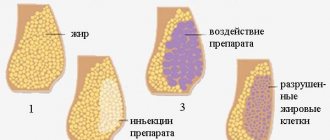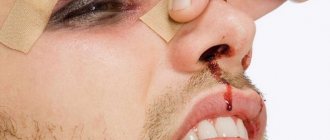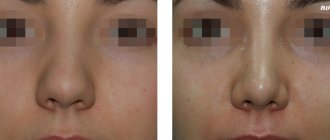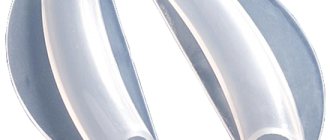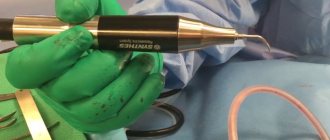Most people are afraid of their ugly nose with defects, and everyone wants to change it.
However, you should first figure out what kind of problem this is and what nature it is - aesthetic or pathological.
When changing the shape of the nose (osteotomy), that is, artificially, the nose is broken and its position is changed and everything unnecessary is removed, and this is a serious operation.
In this article, you will become familiar with the operation of nasal osteotomy, namely what it is, how it is performed, to whom it is indicated, and what recommendations should be followed after this operation.
What is osteotomy of the nasal bones?
Age restrictions. If, nevertheless, the problem is connected specifically with pathology due to illness or injury, then the age of the patients is not taken into account, because defects can spoil the appearance, and also seriously complicate a person’s life, for example, make it difficult to breathe.
Also, defects can contribute to constant inflammation of the nasal mucosa. If the problem is aesthetic and he wants to change his nose, then the age of the patient is necessary.
In females, the nose finishes forming by the age of eighteen, while in males the process will last until twenty to twenty-two years. Naturally, it is not recommended to carry out such an operation at the age of seventeen or eighteen, because as soon as by this age the bone mass and the main cartilages of the nose are formed, and therefore correction and reshaping should be carried out. In a situation where this is directly related to injury or illness, then the age criterion is naturally removed.
Contraindications for surgery
Contraindications for removing a nasal hump are the same as for other procedures during rhinoplasty.
- Acute inflammatory diseases of the upper respiratory tract
- Acute and chronic dermatological diseases of the face
- Individual allergic reactions to certain medications
- The young age before the final formation of the facial skeleton is usually 18-20 years.
- Bleeding disorder
- Severe general diseases
- Pregnancy and lactation period
Most people are afraid of their ugly nose with defects, and everyone wants to change it.
However, you should first figure out what kind of problem this is and what nature it is - aesthetic or pathological.
When changing the shape of the nose (osteotomy), that is, artificially, the nose is broken and its position is changed and everything unnecessary is removed, and this is a serious operation.
In this article, you will become familiar with the operation of nasal osteotomy, namely what it is, how it is performed, to whom it is indicated, and what recommendations should be followed after this operation.
- What is osteotomy of the nasal bones?
- Nasal osteotomy surgery
- Preparatory stage
- Analyzes
- If there are illnesses
- Risks
- Simulation (computer)
- Features of surgical intervention
- Features of the rehabilitation period
- Can marks remain after surgery?
Nasal osteotomy surgery
Preparatory stage
Analyzes
Before the operation, the patient is required to undergo a large number of tests. Based on the results of such tests, the doctor looks at and decides whether to perform surgery or not. This also applies to surgery in aesthetic terms.
If there are illnesses
As for sinusitis, surgery is possible for any disease, unless, of course, it is acute at the time of surgery. Often, sinusitis is caused by a deviated nasal septum, and this cause can only be eliminated by rhinoplasty or osteotomy.
That is why aesthetic rhinoplasty is often combined with surgery as prescribed by a doctor (ENT). All these nuances are indications, which is why the range of preliminary analyzes is very wide. The patient's first order of business is a tomogram. In these x-rays, the doctor looks at the areas of the problem and what caused them.
Risks
The first stage of consultation with a doctor will be to explain the patient’s desires in terms of his nose, that is, what he wants. After this, the doctor will advise what needs to be done and give recommendations. After this, there will be a conversation about the risks and problems that a person may encounter on the operating table. This operation, as already mentioned, is very complex.
The doctor is asked to find out whether the patient will agree to the operation. Every aspect of the operation will be demonstrated so that the patient has a clear understanding of what he is about to do. Very often there have been cases when the patient’s wishes cannot be fulfilled due to the capabilities of medicine. This is why some patients refuse osteotomy surgery around the consultation.
Simulation (computer)
This is the so-called computer visualization, but with all its capabilities, it will not be able to give a real version of what your face will look like after surgery. This is just an approximate idea, because after surgery anything can happen.
Although the percentage of similarity between simulation and reality after surgery is very high, from eighty-five to ninety percent. In any case, you can trust 3D computer modeling.
Features of surgical intervention
At the moment, the duration of the nasal osteotomy operation is no more than sixty minutes. One of the most unpleasant consequences of such operations is bruising and swelling of the face, which lasts up to fourteen days. At the moment when the plaster is removed from the nose, the swelling is almost invisible.
However, they may form over the next two days. We advise you not to leave the house during the rehabilitation weeks. Only in forty to forty-five days will everything return to normal. The final cessation of all processes of appearance can be seen only six months after the operation. The operation has two types - open and closed; with the open one, scars may remain, while with the closed one there will be no scars. The choice of type of operation depends on the wishes of the patient.
It also very much depends on the doctor’s experience, and how accurately he can perform such an operation using one or another technique. Good hospitals use the most advanced technologies, for example, using lasers instead of coagulators to minimize bleeding. This contributes to a very rapid recovery of the patient and instant healing of wounds.
Features of the rehabilitation period
Patients are often concerned with questions such as “Is it true that the nose becomes more fragile and sensitive after surgery?”
In general, this is true, but not forever, but only for six months, and after twelve months the final formation of callus will occur. Until this moment comes, you should be very careful for the first six months.
After six months of recovery, the callus will have formed up to eighty percent and your nose will be strong again. As mentioned earlier, a completely skeletal skeleton will be formed in one year.
Osteotomies
One of the first surgeons to promote osteotomy was Jacques Joseph. He performed it from the bottom up from the piriform opening to the nasal process of the frontal bone. The use of the technique of Joseph and other early rhinoplasty surgeons leads to a high incidence of postoperative nasal breathing disorders.
Important positive technical changes have resulted from the understanding that preservation of the periosteum and lateral suspensory ligaments of the lower lateral cartilages helps reduce the incidence of upper airway obstructions. Therefore, modern osteotomy techniques have been developed that take into account the effect of bone movement on functional and aesthetic outcome.
When performing a nasal osteotomy, the aesthetic goals of the surgeon are (1) closing the open nasal vault; (2) straightening a crooked nasal bridge; or (3) narrowing of the lateral walls of the nose. From a functional point of view, the surgeon must consider the possible impact of the osteotomy on the patient's nasal airway.
The structure of each patient's nose is unique. In general, the osteotomy should be limited to as thin a portion of the nasal wall as possible. The average thickness of the nasal wall along the osteotomy should be 2.5 mm. The following techniques are commonly used: lateral osteotomy, performed either by perforation or linear method; medial osteotomy; superior osteotomy and intermediate osteotomy.
Lateral osteotomy
Lateral osteotomies are performed to close the open dorsum (open roof) and narrow or straighten the bony pyramid of the nose. There are two main methods of performing it: linear (one cut) and perforation. In the linear method, an osteotome is used to create a bone cut along the pterygofacial groove (Fig. 3). Most often, osteotomy is performed high (anterior), low (posterior), high (anterior) way.
Rice. 3. Lateral osteotomy begins at the anterior end of the inferior turbinate and is first carried out perpendicular to the end of the piriform opening (position 1). After this incision, the osteotomy line is curved towards the area of the medial canthus (position 2) (adapted from Larrabee WF Jr. Open rhinoplasty and the upper third of the nose. Fac Plast Surg Clin North Am 1993;1(1):30) .
The lateral osteotomy begins at the level of the inferior turbinate attachment. To preserve the lateral attachment of the suspensory ligaments, the small triangle of bone at the piriform foramen is left intact. This helps keep the airway open. Next, the osteotomy line continues along the pterygofacial groove until it curves upward and anteriorly to the thinnest part of the nasal bone at the level of the lower edge of the orbit.
A superior reverse fracture can be made by rotating the osteotome, applying finger pressure, or using a percutaneous superior transverse osteotomy. In the latter case, a small cut in the skin is made with a 2-mm osteotome in the middle of the distance between the bridge of the nose and the area of the medial canthus. Three or four small perforations are made through this point using the same osteotome, allowing the nasal bone to be mobilized without disrupting the support of the periosteum.
The perforation method can also be used to perform lateral osteotomy. A series of perforations are made along the desired fracture line, either percutaneously or from the nasal cavity. A nasal perforator osteotomy can also be used to “push out” nasal bones that have been displaced medially as a result of previous trauma or surgery.
Cadaveric studies have shown that the perforator technique maintains greater periosteal support than the linear technique. When using a linear osteotomy, it is better to correct very deviated noses or noses with thick lateral walls.
Medial osteotomy
Medial osteotomies are performed when the lateral walls of the nose need to be mobilized. They are often used to correct a crooked nose or to narrow a wide nose without a hump. Medial osteotomies form the angle between the nasal bone and the septum and are carried upward until they contact the superior osteotomy line or the site of the reverse fracture (Fig. 4).
Rice. 4. Medial osteotomies are not always performed, but when necessary, for example, with a very wide or very crooked nose. A straight or curved osteotomy creates a controlled incision at the transition to the thicker frontal bone (adapted from Larrabee WF Jr. Open rhinoplasty and the upper third of the nose. Fac Plast Surg Clin North Am 1993; 1(1):29).
Intermediate osteotomy
1) narrowing of a very wide nose that has sufficient height (bilateral osteotomy);
2) correction of a crooked nose, when one side wall is much longer than the other;
3) straightening a noticeably arched nasal bone.
The intermediate osteotomy is performed parallel to the lateral osteotomy, approximately along the middle portion of the lateral wall of the nose. The exact medial/lateral location of the osteotomy line along the lateral nasal wall can be changed depending on the objectives of the operation. Closed rhinoplasty is usually performed with a small osteotome (eg, 3 mm) through an intercartilaginous incision and guided in a cephalic direction to the superior fracture site.
Can marks remain after surgery?
This question is a bit perplexing, because there is no clear answer. In some cases, the consequences of the operation are very minor, so much so that they simply cannot be distinguished.
At some points the changes are very obvious, mainly due to a failed operation. And the point here is not in postoperative scars or scars, but in the incorrect shape of the nose. That is why we advise you to choose the right doctor and clinic.
Combination of operations
Sometimes, to remove a nasal hump, it is necessary to bring the nasal bones together, which costs about the same as the operation to remove the hump itself. Also, clients often order correction of the wings of the nose in combination with other operations. All this is reflected in the final price of the plastic surgeon’s services.
The full cost of all operations in this case is calculated individually and depends not only on the characteristics of the client’s nose, but also on the pricing policy adopted in this plastic surgery center.
The most difficult thing is to independently calculate the approximate price for a complete nose correction, since the client may need each type of rhinoplasty to a greater or lesser extent. The price for a complete nose correction is 29,000 – 385,000 rubles. The average cost of transformation is 130,000 - 170,000 rubles.
Popular articles
- The success of a particular plastic surgery largely depends on how...
Lasers in cosmetology are used quite widely for hair removal, so...
It's no secret that Botox injections today...
A woman’s eyes are a reflection of her inner world. They express
…
The term "osteotomy" is borrowed from Greek and means a surgical procedure in which a piece of bone is removed (to correct appearance). This article describes the technology of cutting out parts of bone tissue during rhinoplasty (plastic surgery on the nose).
Problem
Some rhinoplasty operations are performed without osteotomy; standard rhinoplasty requires moving or changing the cartilage tissue that actually makes up the nose.
Clarifications
According to 2004 statistics, more than 305,000 rhinoplasty surgeries (both cosmetic and reconstructive) were performed by surgeons who were members of the American Society of Plastic Surgery (ASPS). For each of these operations, perhaps 2 to 4 osteotomies were performed. Thus, this gives an idea of how often osteotomies are performed during surgery. Typically, indications for osteotomy are a hump on the nose (removal of the hump) or a too wide nasal bridge. When performing osteotomy, of course, it is necessary to take into account a set of factors: the anatomy of the nose and the entire face, skull, and have an artistic flair.
Anatomy
In a nutshell, the nose is a structure made up of bone, cartilage framework and skin. The size, texture and placement determine the appearance of the nose. The bony part is called the “bridge of the nose.” Typically, the back is paramidal in shape.
Contraindications
Contraindications to osteotomy are closely related to contraindications to rhinoplasty. If the surgeon believes that rhinoplasty is possible for the patient, then there is no reason not to perform an osteotomy. Perhaps, for aesthetic reasons, there is no need to remove the hump, make the bridge of the nose absolutely straight or thinner, in this case, osteotomy is not necessary. Ultimately, the decision is made by the surgeon.
Research
Each patient must undergo an appropriate medical examination and tests before rhinoplasty/osteotomy. Including the following medical tests: general clinical blood test test for blood clotting time and bleeding duration test for blood sugar and prothrombin index make an electrocardiogram of the heart pregnancy test (for women) test for AIDS, Hepatitis B and C
Treatment
In addition to correcting the nasal septum and deviations, rhinoplasty can be a purely aesthetic procedure. In this case, only the patient decides whether to go to the surgeon.
Preoperative details.
Preoperative charting of patients is an integral part of rhinoplasty. Photos are taken from the front, profile and half-turn. Before the operation, photographs are reviewed and all points with which he is dissatisfied are discussed with the patient. Recently, computer programs that process photographs and allow the patient to see approximate results of the operation have become increasingly popular. Surgeons using such programs must explain to the patient that the final result is not guaranteed to be the same. Patients should take into account that the likelihood of scarring and recovery time after surgery are highly individual for each individual.
Typically, patients spend the recovery period after rhinoplasty at home and are able to withstand moving from the hospital. The patient does not choose anesthesia on his own, except for a few exceptions, the choice of anesthesia is up to the surgeon.
During surgery
Osteotomy is usually performed at the final stage of rhinoplasty. At this time, the surgeon may stitch the incisions and place cotton swabs in the nostrils to compress the blood vessels and stop bleeding. In addition, osteotomy is performed at the very end of the operation, because this allows you to avoid severe post-operative swelling.
After operation
The patient may have a slight nose bleed, which should stop 10 to 12 hours after surgery. There will also be blue and black bruising around the eyes (the result of an osteotomy). Bruises should disappear in 1-2 weeks. After surgery, you need to refrain from physical activity and sports for 4-6 weeks.
Osteotomy is a medical dissection of bone tissue (artificial fracture). This technique is used to correct improperly fused bones, for complications after rickets and for the treatment of arthrosis.
Osteotomy and rhinoplasty
In plastic surgery, osteotomy is often associated with rhinoplasty. With its help, the hump of the nose is eliminated, the height and width of the nasal wall is changed, and breathing is restored. But you need to know that not every correction requires an osteotomy. If you just want to correct the tip or wings of your nose, then the surgeon will only need to correct the cartilage tissue. And even for a slight change in shape, you can get by with the installation of autografts.
Preparing for surgery
It is important to remember that osteotomy is a serious surgical procedure and requires careful preparation. First, the doctor will model your future appearance on the computer so that you can imagine what you are going for. This will be followed by a comprehensive examination of the body: several blood tests, an ECG, fluorography, and a dental examination. All this is necessary to reduce possible complications to zero. This stage will take approximately seven days.
Three weeks before surgery you will have to stop smoking and drinking alcohol. You should also not visit a solarium or take blood thinning medications (for example, aspirin and ibuprofen). In a week you will need to reduce the use of facial cosmetics. The day before surgery, you should not eat or drink for at least eight hours before the procedure.
Progress of the operation
An osteotomy is performed using a special surgical chisel. Modern instruments eliminate severe tissue trauma - they are regularly sharpened during surgery. There are several osteotomy techniques. The surgeon decides which one to use during examination, taking into account the anatomy of the nose and the patient’s wishes.
An osteotomy is performed at the final stage of the operation, when all other corrections have been made. The surgeon sews up the previously made incisions and clamps the vessels with cotton swabs. This helps reduce post-operative swelling and avoid bleeding. Then the excess bone tissue is removed. To do this, several incisions are made inside the nasal cavity, so the scars from them will not be visible. Osteotomy is performed only under general anesthesia for 1-2 hours.
Contraindications
Osteotomy is a serious surgical intervention on the body, and therefore its contraindications are the same as other serious operations:
- diabetes
- cardiovascular diseases
- inflammatory processes in the body
- blood clotting problems
There is no point in having surgery at an early age (before 16 years). The osteochondral system of the body at this time is not yet fully formed, and there is a high probability that the nose will still have time to change its shape.
How predictable is the result of non-surgical correction?
When it comes to correcting the tip of the nose or straightening a hump, the results are almost always 100% successful. If the effect is not fully achieved, then the situation is almost always corrected by adding fillers, especially since they can be kneaded after injection and carefully distributed. In addition, the cosmetologist must have an antidote, which is administered if something goes wrong, and thus removes the injection of fillers.
Finally, it is worth saying that there is no need to prepare for non-surgical rhinoplasty; there is no need to undergo any special tests. There are no special contraindications in this area of cosmetology, with the exception of general ones: after the administration of botulinum toxin, you should refrain from visiting the sauna and swimming pool, taking antibiotics and alcohol for two weeks. In the case of fillers, the restrictions are the same: the main thing is not to introduce an infection into the small wound left by the cannula.
